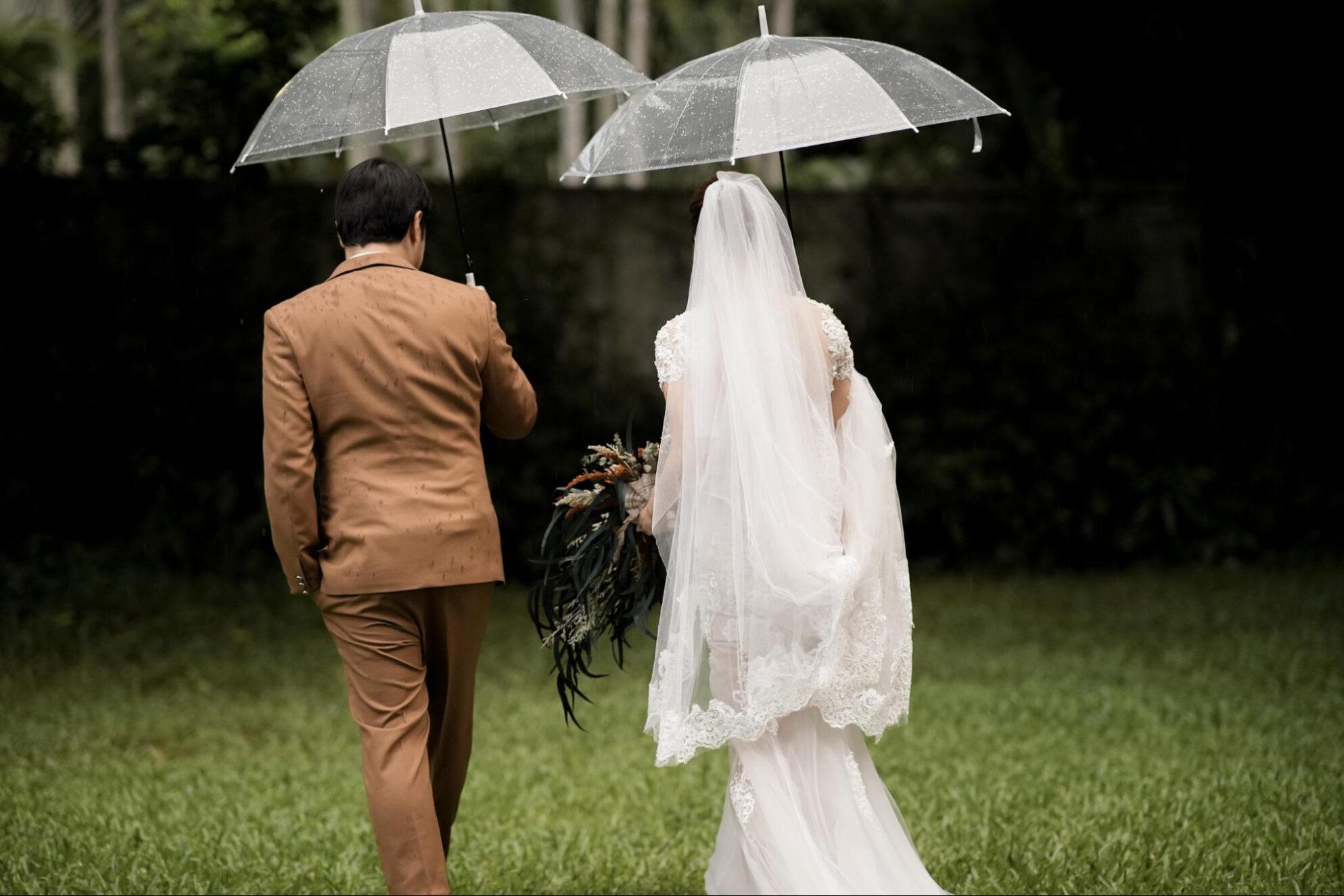Wedding Superstitions, Explained.
Did you ever wonder why the month of June became the popular month to get married in? Or why the bridal wear includes a veil? Or why is there a bouquet toss at the reception?
In this blog, we will uncover the secrets behind popular wedding rituals and traditions. Join us as we unravel the mysteries behind these age-old superstitions and uncover the true meaning behind them. Get ready to be surprised!
1. Something Old, New, Borrowed, and Blue
This custom has been around for centuries and is filled with symbolism and meaning for the bride and groom. The tradition of wearing something old, new, borrowed, and blue is more than just a rhyme – it carries deep symbolism. It’s a beautiful way to incorporate meaningful items into the wedding attire, plus some good luck charm hidden in every aspect of the bride’s ensemble!
Something old represents the bride’s connection to her past and her family history. It can be a piece of jewelry, a handkerchief, or even a dress that has been passed down through generations. By incorporating something old into her wedding attire, the bride is honoring her roots and heritage.
Something new symbolizes the couple’s future together and the fresh start they are embarking on as husband and wife. It can be a new piece of jewelry, a pair of shoes, or any item that represents the beginning of their journey as a married couple. Incorporating something new into the wedding attire signifies optimism and hope for the future.
Something borrowed involves borrowing an item from a happily married friend or family member, with the belief that their happiness and luck will be passed on to the bride. It can be a veil, a piece of jewelry, or any meaningful item that holds sentimental value. By including something borrowed in her ensemble, the bride is inviting love and support from her loved ones into her marriage.
Something blue.The color blue has long been associated with fidelity and love, making it a popular choice for this tradition. The bride can incorporate something blue into her attire through a blue garter, a piece of jewelry, or even blue shoes. This element symbolizes the couple’s commitment to each other and their faithfulness in their marriage.
2. Crying as you walk down the aisle
Have you ever heard of the superstition that crying while walking down the aisle on your wedding day can actually bring you a lifetime of happiness?In some cultures, crying on your wedding day is believed to bring good luck and prevent future tears. It is said that shedding tears of joy symbolizes the release of any past sorrows, making room for happiness in your marriage.So if you find yourself tearing up as you walk down the aisle, remember that it might just be a sign of a long and happy life together. So, grab that waterproof mascara and let those happy tears flow!
3. Seeing your soon-to-be before the wedding march
Many couples choose not to see each other before walking down the aisle, believing that it could bring bad luck. This superstition dates back to the time of arranged marriages when it was thought that if the groom caught a glimpse of the bride before the ceremony, he might change his mind about marrying her. While some couples still adhere to this tradition, others choose to share a special moment before the wedding without any negative consequences. It’s all about personal belief and what brings you and your partner the most joy on your special day. Nowadays, many couples opt for a “first look” before the ceremony, capturing that special moment on camera. It’s a modern twist on an old tradition.
4. Why June is the most popular month for weddings
Well, according to ancient traditions, June is associated with the Roman goddess Juno, who was the goddess Juno, who was the protector of women and marriage. People believed that getting married in June would bring them luck and blessings from Juno herself. Many couples choose to get married in June because of its warm weather, beautiful flowers, and the belief that it’s the luckiest month for weddings.
At Jardin de Miramar, June is a peak season for weddings, with couples flocking to our beautiful venue to exchange vows amidst lush gardens and picturesque landscapes. So, if you’re planning a wedding and looking for some good luck, consider booking in advance.
5. Why is there a garter and bouquet toss?
The garter and bouquet toss are two playful wedding traditions that have roots in ancient superstitions. In medieval times, couples who get married are deemed fortunate. The bride’s bouquet symbolizes fertility and happiness, while the garter was thought to bring luck in love.
The garter toss dates back to medieval times when it was believed that obtaining a piece of the bride’s clothing would bring good luck. The bouquet toss, on the other hand, originated in England during the Victorian era when unmarried women would scramble to catch the bride’s tossed flowers in hopes of securing a marriage of their own. Today, these customs are carried on as fun and lighthearted ways to involve guests in the celebration.
6. Why brides wear a veil
The tradition of brides wearing veils dates back to ancient times when they were believed to protect the bride from evil spirits. It was also thought to symbolize modesty and purity. Today, veils are still a popular accessory for brides, adding an air of mystery and romance to their wedding day look.
So next time you see a bride walking down the aisle with a veil, remember the centuries-old tradition and the symbolism behind it.
7. Why the groom needs to carry the bride over the threshold of their new home
This tradition stems from the belief that evil spirits linger at the threshold of a new home, waiting to enter and cause mischief. To protect the bride from any harm, the groom would carry her over the threshold, symbolizing his strength and protection.
Today, it’s seen as a romantic gesture symbolizing the bride’s transition into her new life with her husband. So if you’re getting married soon, don’t forget to add this sweet tradition to your big day!
8. Rain on your wedding day
They say rain on your wedding day is a sign of good luck. It means a cleansing of the earth and the rebirth of plants. Many cultures believe that rain symbolizes cleansing, renewal, and fertility.
Modern brides pray for a sunny wedding day for the reasons of convenience. While here in the Philippines, rains can lead to floods and no one wants to get stuck in the mud (literally!) So, it is best to pick venues that have rain-proof facilities and are away from the flood-prone areas.
Luckily, we have the perfect solution for you. Check out how to have a worry-free wedding, rain or shine in this outdoor venue away from flood-prone areas.
9. Saturday is the unluckiest day to get married
In many cultures, Saturday is seen as a day filled with negative energy and bad luck. Some believe that getting married on a Saturday can lead to a marriage filled with hardships and challenges. This superstition has been passed down through generations, and many people still adhere to this belief today.
An ancient Celtic poem reads: “Monday for wealth, Tuesday for health, Wednesday the best day of all, Thursday for losses, Friday for crosses, and Saturday no luck at all.” (Brides.com)
One possible explanation for this superstition is rooted in ancient folklore and religious beliefs. In some cultures, Saturday is associated with the god Saturn, who is often linked to misfortune and hardship. Funny because Saturday seems to be the most popular day to get married in! Well, this one’s obvious. In contemporary times, a big percentage of guests are usually free on weekends.
Saturday may be considered the unluckiest day to get married, but at Jardin de Miramar, it’s a preferred day for tying the knot. With its stunning gardens, elegant venues, and professional staff, your Saturday wedding at Jardin de Miramar is sure to be a dream come true, turning superstitions into celebrations of love and happiness.
10. Ringing Bells
When it comes to wedding traditions, ringing bells holds a special significance. This age-old superstition is believed to bring good luck and ward off evil spirits. From church bells to personalized wedding bell favors, the sound of ringing bells is said to fill the air with positive energy and blessings for the newlyweds.
In many cultures, the ringing of bells is believed to symbolize the start of a new chapter in the couple’s life together. The sweet sound of bells ringing is thought to bring harmony and joy to the marriage, creating a sense of happiness and love that will last a lifetime.
So, as you plan your wedding day, consider incorporating the tradition of ringing bells to bring prosperity and happiness to your union. Whether you choose to have guests ring small bells as you walk down the aisle or have a bell-ringing ceremony at the end of your reception, embracing this superstition can add a touch of whimsy and magic to your special day.
Summing it Up!
Wedding superstitions have been around for centuries, rooted in tradition and folklore. These superstitions add an extra layer of fun and excitement to the big day, making it even more memorable for the bride, groom, and guests alike. They add an element of whimsy and fun to the wedding planning process. By incorporating these wedding superstitions into your special day, you are not only honoring tradition but also adding a touch of whimsy and charm to your celebration.
Whether you choose to embrace these traditions or create your own, one thing is for sure – weddings will always be surrounded by a touch of magic and mystery. The most important thing is to create a day that is meaningful and memorable for you and your loved ones.
So, don’t be afraid to break a few old-fashioned rules and create your own happily ever after. After all, love is the most powerful force in the universe, capable of conquering even the most stubborn of superstitions. Cheers to love, laughter, and a lifetime of happiness together!



